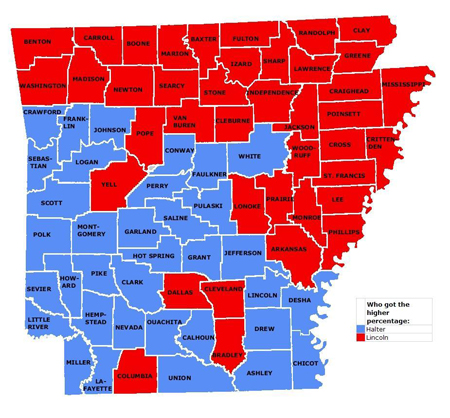It's primary day in a few states around the country. Accountability Now PAC launched the "Draft Halter" website just a few months ago to encourage Lt. Governor Halter to run for the U.S. Senate in Arkansas and we are thrilled to see what a great job he has done so far and rooting for a big win for him today. Because of the large interest in the race, we thought it would be good to share a quick preview of what to watch for tonight as the returns start coming in.
First of all- in terms of turnout, Arkansas Democratic primaries have been very consistent over the past two decades. In much of the state (with the exception being the northwest corner where Wal-Mart is headquartered) local Democrats dominate in almost every county for local and state positions. That leads to two things- 1) A large number of otherwise Independent or Republican voters that are registered as Democrats to influence primary elections that really count and 2) the consistent turnout described above. While it can fluctuate by county depending on where there are local races, turnout in the last four Democratic primaries in midterm election years were 334,682 (1994), 318,801 (1998), 279,977 (2002) and 290,720 (2006). Turnout should be between about 350,000-400,000 voters today in the Democratic primary.
Arkansas also requires candidates to receive 50% of the vote in the primary to move on to the general election. If no candidate receives 50%, the race goes to a runoff in three weeks.
When Lincoln first ran for this seat in 1998, she was in a four way primary- finishing with 45.5%, short of the 50% needed to win on the 1st ballot. This support was not equally distributed across the state though. In the 1st Congressional District (northeast Arkansas) which Lincoln had represented for two terms in the U.S. House, Lincoln scored 64.2% of the vote. Across the other three Congressional Districts in Arkansas, Lincoln only scored 37.7% of the vote. The greatest danger for the Halter campaign tonight is the retirement of Congressman Marion Barry in the 1st District- which set off a contested Democratic primary there to replace him. If turnout across the 1st District is much higher than the rest of the state, Blanche has a plausible path to 50% of the vote today. If not, the math becomes very difficult for her to avoid a runoff.
We also have some clues from Halter's bid for Lt. Governor in 2006, which was also a four way Democratic primary. In that election, Halter received almost exactly 40.0% of the vote- enough for 1st place and advancing him to a runoff that he won three weeks later. There were only 10 counties where Halter won over 50% of the vote- but they are some of the biggest and most influential counties in Arkansas Democratic politics. Five of those- Pulaski, Saline, Faulkner, Lonoke and Jefferson are the ones to watch for Halter tonight. A win for the Halter campaign is forcing this election to a runoff- and he will need to be above or near 50% of the vote in all five of those counties to have any chance of doing that.
Another thing to check out tonight- the counties outside the media blitz that has been on Arkansas television over the past few months. Most of those TV ads focused on three media markets- Little Rock, Jonesboro and Fort Smith. That will cover about 75%-80% of primary voters today but the remainder are in smaller, out of state media markets on the edges of the state. Lincoln will likely score a big margin in the Memphis market that covers part of the 1st Congressional District- but keep an eye out for results along the southern border of the state with Louisiana- as most of those counties have not seen the same blitz on broadcast TV that the rest of the state has. These nine counties are Columbia, Hempstead, Howard, Lafayette, Little River, Miller, Sevier, Ashley, and Union, In some ways, those counties may be the most interesting to analyze after election day, as they may provide some strong hints to whether or not the TV advertising blitz on both sides of this primary made a difference in the results.
Finally, we close with a map that may sum this election up even more simply than my words above. Taking the Lincoln primary of 1998 where she scored 45.5% and the Halter primary of 2006 where he scored 40.0%, we overlayed them on a map of Arkansas to see who started out stronger in each county. As you can see, there is a clear regional split- with Blanche dominating to the north and east, and Halter stronger in the central and south.
